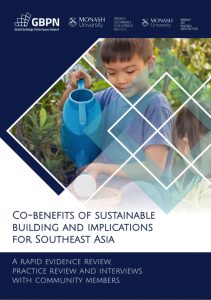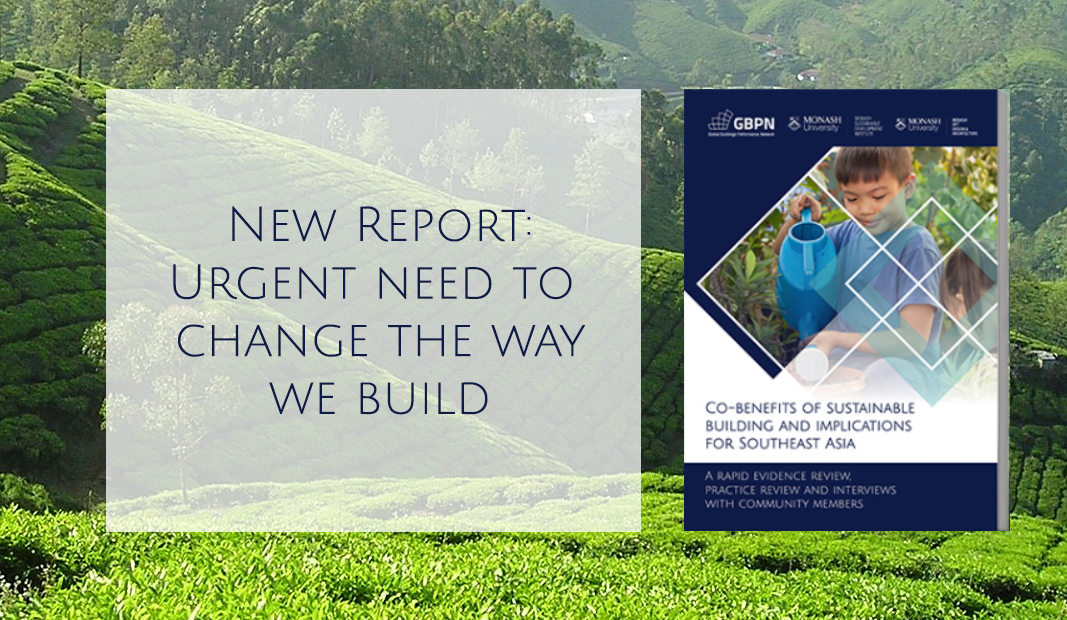New report: Urgent need to change the way we build
A new GBPN and Monash University report reveals that sustainable building practices not only benefit the environment but also have wide-ranging benefits for people. However, there is little evidence to show that these benefits are being used as an incentive to encourage further sustainable building, despite the obvious economic potential in marketing the benefits as a point of difference.
Commissioned by GBPN and Monash Faculty of Art, Design and Architecture (MADA), the Monash Sustainable Development Institute’s Evidence Review Service led the rapid research and practice review which highlights benefits including improved mental and physical health, economic benefits and energy savings, in addition to the positive environmental impacts offered by sustainable building practices.
This highlighted the urgent need to immediately reform the way we design and build. Over the next two decades, humans will construct another 280 billion m2 of buildings, meaning we’re expanding our building footprint faster than at any time in human history.
These buildings not only require resources to construct, but if they are not designed to sustainably manage thermal comfort and maximise natural light and ventilation this results in ongoing elevated energy consumption for the life of the building. So we not only need to build better but also design better.
There is no “status quo” option
CEO of GBPN and Associate Professor in Architecture at MADA, Dr Peter Graham said, “We have an urgent environmental imperative to change the way we build if we are to keep global warming well below 2oC. This report shows that people’s health and well-being also improve when they live in sustainable buildings.”
However, there are barriers to deploying better design and construction in the building sector. Among these is the data gap – not enough substantial research has been done to fully explore and quantify the benefits of sustainable building.
“The fact that these benefits are not always part of a policy case to support designing and constructing more sustainable buildings shows there is still a lot of work to be done to promote these co-benefits,’ Dr Graham said.
“Firstly, there is a need for further research to quantify and monetise the economic, health and other benefits of sustainable building; and secondly, we need to educate the industry and the public about these benefits to drive up market demand.
“Ultimately, the goal is to transform the way we build, which will not only make a significant contribution to reducing emissions and curbing global warming – it will promote health and economic benefits.”
The full report is available here: Co-Benefits of Sustainable Buildings and Implications for Southeast Asia

Scroll down to view the video gallery
Video Gallery
Building Better for All – Low Cost Sustainable Housing in Jakarta
Bangunan Hijau untuk Semua – Manfaat Bangunan Berkelanjutan
INDIVIDUAL STORIES
Caring for children’s health
Missel Yunengsih, Daan Mogot Low Cost Green Apartments, Jakarta
Healthy Buildings, Healthy Lives
Yodi Danusastro, Sustainability Consultant
Children Can Play Freely
Yuli Armadianti, Daan Mogot Low Cost Green Apartments, Jakarta
Benefits of Living in Green Buildings
Pooja Shukla, Senior Director, Green Business Certification
Sustainable Buildings Save Money
Yuli Armadianti, Daan Mogot Low Cost Green Apartments, Jakarta
Share This Story, Choose Your Platform!
Stay in touch with how we’re transforming the buildings sector
GBPN runs innovative building policy reform programs in key regions around the world that aim to tackle the climate emergency by decarbonising the buildings sector. Stay up to date with our newsletter.
Stay in touch with how we’re transforming the buildings sector
GBPN runs innovative building policy reform programs in key regions around the world that aim to tackle the climate emergency by decarbonising the buildings sector. Stay up to date with our newsletter.







